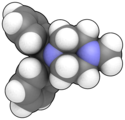Cyclizine
 |
|
 |
|
| Clinical data | |
|---|---|
| Trade names | Marezine, Valoid, Nausicalm, others |
| AHFS/Drugs.com | Consumer Drug Information |
| Pregnancy category |
|
| Routes of administration |
by mouth, IM, IV |
| ATC code | |
| Legal status | |
| Legal status | |
| Pharmacokinetic data | |
| Metabolism | N-demethylated to inactive norcyclizine |
| Biological half-life | 20 hours |
| Identifiers | |
|
|
| CAS Number | |
| PubChem CID | |
| IUPHAR/BPS | |
| DrugBank | |
| ChemSpider | |
| UNII | |
| KEGG | |
| ChEBI | |
| ChEMBL | |
| ECHA InfoCard | 100.001.314 |
| Chemical and physical data | |
| Formula | C18H22N2 |
| Molar mass | 266.381 g/mol |
| 3D model (Jmol) | |
|
|
|
|
Cyclizine, sold under a number of brand names, is a medication used to treat and prevent nausea, vomiting and dizziness due to motion sickness or vertigo. It may also be used for nausea after general anaesthesia or that which developed from opioid use. It is taken by mouth, in the rectum, or injected into a vein.
Common side effects include sleepiness, dry mouth, constipation, and trouble with vision. More serious side effects include low blood pressure and urinary retention. It is not generally recommended in young children or those with glaucoma. Cyclizine appears to be safe during pregnancy but has not been well studied. It is in the anticholinergic and antihistamine family of medications.
Cyclizine was discovered in 1947. It is on the World Health Organization's List of Essential Medicines, the most effective and safe medicines needed in a health system. In the United States it is available over the counter. In the United Kingdom 100 tablets costs about 11.26 pounds. It is occasionally used for the "high" it can create.
Nausea, vomiting and dizziness associated with motion sickness, vertigo and post-operatively following administration of general anaesthesia and opioids. It is sometimes given in hyperemesis gravidarum, although the manufacturer advises that it be avoided in pregnancy. Off-licence use often occurs with specialists in hospitals to treat inpatients who have become severely dehydrated in pregnancy. An off-label use is as an opioid/opiate potentiator.
...
Wikipedia
